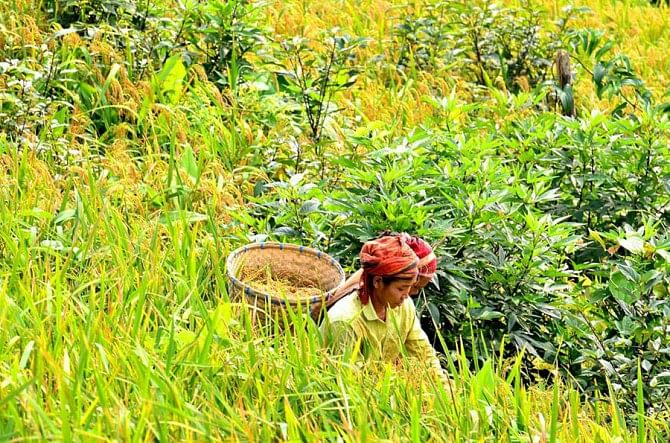Bumper paddy yield brings smile to jhum farmers

Bumper yield of paddy brings smile to the traditional jhum farmers in different areas of Chittagnong Hill Tracts (CHT) this aus season.
Indigenous jhum farmers have already started harvesting the paddy, often following 'Dhan Fang', an occasion marked by sacrificing of cocks and pigs, in line with age-old social custom aimed at making the event auspicious.
Almost all the areas of Bandarban, Rangamati and Khagrachhari hill districts see jhum cultivation that has traditionally served as major source of livelihood for the indigenous people.
However, the areas known for large-scale paddy farming are -- Baghaichhari, Barkal, Jurachhari and Bilaichhari upazilas in Rangamati, Thanchi, Alikadom, Lama and Ruma in Bandarban, and Panchhari, Dighinala and Laxmichhari in Khagrachhari district.
Some 17,630 hectares of hill areas including 9050 hectares in Bandarban, 6385 hectares in Rangamati and 2195 hectares in Khagrachhari have been brought under jhum cultivation this year.
Last year, jhum farming on 14,691 hectares of land produced 22,932 tonnes of rice, per hectare yield being 1.41 tonnes.
The output will be much more this year, said sources of the Department of Agriculture Extension (DAE), adding that timely rainfall, favourable weather, proper use of fertiliser and relatively less pest attack are the reasons behind the good yield.
Jhum farmers produce varieties of scented rice like Rengui Dhan, Dhub Pattigi, Ranga Pattigi, Mumboi, Amei, Bhuppoi, Kamarang, Dalu Kamarang, Hoborak, Horingbini, Bandoronagbini and Laxmibini.
Besides, maize, sesame, cotton, pumpkin, chilli, eggplant, cucumber are grown in jhum farms, said DAE sources.
The jungle is cut in January-February and the remains are brunt down in April for preparing the land for jhum cultivation and then farmers sow seeds of paddy and others crops.
“With good yield this year, I hope to get 150 maunds of rice, while I got only 80 maunds last year,” said Manikya Ratan Chakma of Ujjangchhari in Barkal upazila.
Jhum farmers Jyoti Lal Chakma, Utpol and Chikka Chakma in Sijok, and Remon Pankhua in Sajek of Baghaichhari also expressed hope of better yield.
“Locals produce very tasty and scented varieties of rice through jhum farming. Several other crops are also grown in this way,” said Tarun Bhattacharjee, additional deputy director of DAE.
Our field officers are providing technical support to the farmers and motivating jhum farmers to use balanced fertiliser to get better output, he said.

 For all latest news, follow The Daily Star's Google News channel.
For all latest news, follow The Daily Star's Google News channel. 



Comments